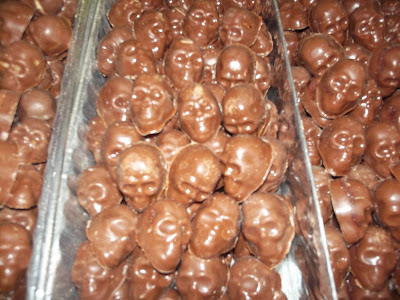*This blog is not endorsed by the US Department of Education or COMEXUS.*
So, it's, uh, been a while. In case you forgot, I'm Bethany.
Nice to meetcha again
Sticking to the theme of posting about events a month after they happen, please allow me to inform you about a significant and interesting difference between Mexican and U.S. American culture:
Día de Muertos!
You've probably heard of Day of the Dead and/or seen the movie "Book of Life." It's a film filled with piñatas, music, candy, vibrant colors and bullfighters. I know this because I saw a poster for it once, I think. Halloween is a similar, but by no means equivalent, holiday in the United States.
Both holidays have macabre overtones-- skulls, coffins, graves-- but the view of death is entirely different. Halloween is about scaring people and getting scared. It's about candy, costumes, and more candy. It's about having fun. Día de Muertos (Day of the Dead) has a much deeper religious meaning that, even in the modern day, underpins all its traditions. I will talk more about the meaning of Día de Muertos in Part 2 of this post.
(This part is boring and about history, skip down to the photo if you are also boring)
Halloween used to have more religious significance than it does today. Samhain, a Celtic holiday celebrated on the night of October 31st, was considered the night when the "veil" between Earth and the spirit world was thinnest. To avoid being recognized by any mischievous spirits that would do them harm, people disguised themselves as spirits. *
The religious significance of Halloween has long been forgotten, although some religious groups discourage its celebration because of its seemingly close relationship with "demonic forces." I don't have a degree in applied theology so I'm not certified to label Halloween as "horrible pagan sin" versus "harmless fun." Rather than engaging in that heated discussion, I'd like to provide you with a picture of me dressed up as a strawberry:
whoa look at that cute little kid. I bet she's gonna marry a hot guy one day
Día de Muertos, while death-focused, is NOT the same as Halloween, and still retains its religious beliefs. More on this in Part 2 of this post. Meanwhile, Part 1 (which you are reading now) deals with a Día de Muertos tradition that is particular to my city, Toluca.
La Feria del Alfeñique
"Feria del Alfeñique" roughly translates to "Fair of Artisanal Sugar Goods" (very roughly). It's a tricky word 'cause it's got that weird squiggly thing in it, so here I kindly provide you with a HANDY-DANDY PRONUNCIATION VIDEO:
In the center of Toluca there is a huge city block lined with antique-ish plaster arches and filled with high-end shops. These arches are referred to as the "Portales" (which translates to-- take a wild guess-- "arches").
yes sir, that's them, those are the Portales that killed my wife
These arches are the annual location of dozens of stands selling sugar goods. For the month of October, artisans who have spent the whole year preparing colorful, intricate wads of sucrose peddle their wares to the general public. Since I have written a lot of words, I will now include a lot of pictures to balance it out:
Here is an example of a typical alfeñique stand at the fair.
Sugar skulls are a well-known symbol of Día de Muertos. Yes, they are really made of sugar, and Yes they can be eaten.
Here is a beautiful specimen (Latin: Craneus Delicious) that I found in the local alfeñique museum.
Also traditional are "borregos" (sheep) made from a sweet pumpkin-seed paste.
This one's gonna Blow Your Mind: this is a tiny candy figurine of a stand selling tiny candy figurines. WHAT
Also present in the alfeñique museum were Flailing Soccer Player Skeleton (above) and Inexplicable Moustache Nun Skeleton (below).
why?
Since I live close to the city center, where the Portales are located, I frequently had the opportunity to visit the fair. I bought myself some sugar skulls to decorate my room (and also a tiny sugar pomegranate, which the ants found pretty quick). The Alfeñique Fair was a really memorable experience because it is not only distinctively Mexican, but also distinctively Tolucan.
Some last pics to finish up before we move on to Part 2, the Day of the Dead altar and celebrations.
An army of Sugar Sheep ready at a moment's notice to march on your home and devour some Childrenchops, in a shocking (and ironic) turn of events
Itty bitty chocolate skulls filled with delicious things like Bailey's and eggnog and brain matter
A professionally taken picture of the stalls inside the Portales (will give you the number of the photographer if you need any other stunningly average photos taken)
Read Part 2 here (oops, not yet written)
Works Cited
* "Halloween." Wikipedia. https://en.wikipedia.org/wiki/Halloween















